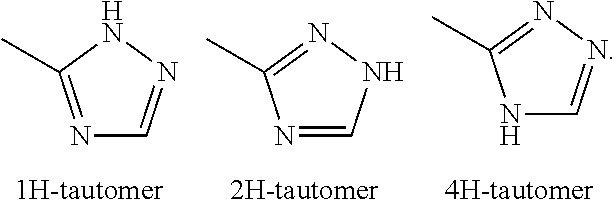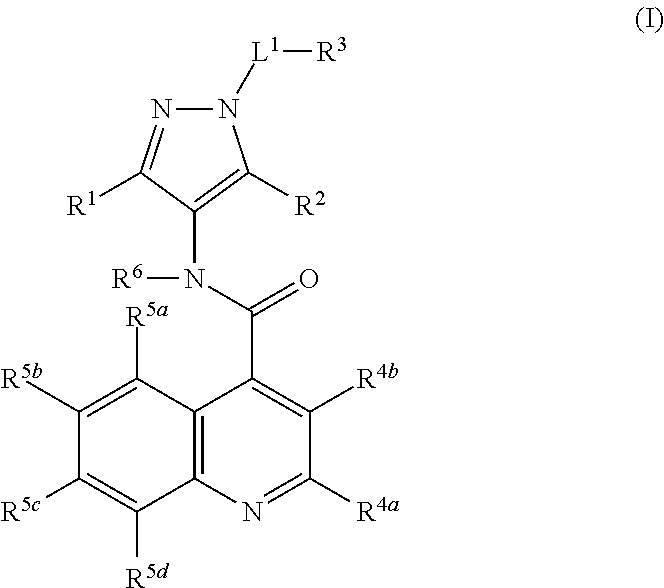Glucose transport inhibitors
a technology inhibitors, applied in the field of glucose transport inhibitors, can solve the problems of increasing cancer's vulnerability to external interference in glycolysis, increasing cancer's potential for metastasis and invasiveness, and cancer cells slowing down growth or starving
- Summary
- Abstract
- Description
- Claims
- Application Information
AI Technical Summary
Benefits of technology
Problems solved by technology
Method used
Image
Examples
example 1
N-[1-(4-fluorobenzyl)-3-methyl-1H-pyrazol-4-yl]-2,6-dimethylquinoline-4-carboxamide
[0759]
[0760]To a solution of 245 mg (1.19 mmol) of a mixture of 1-(4-fluorobenzyl)-3-methyl-1H-pyrazol-4-amine and 1-(4-fluorobenzyl)-5-methyl-1H-pyrazol-4-amine (intermediate 1C) in 4.0 mL DMSO was added 453 mg (1.19 mmol) HATU, 0.26 mL N,N-diisopropylethylamine and 200 mg (0.99 mmol) commercially available 2,6-dimethylquinoline-4-carboxylic acid. The reaction mixture was stirred for 20 hours at 25° C. This mixture was directly purified via preparative HPLC (method A1) to obtain 208 mg (51%) of the desired title compound together with 92 mg (23%) of the regioisomer N-[1-(4-fluorobenzyl)-5-methyl-1H-pyrazol-4-yl]-2,6-dimethylquinoline-4-carboxamide.
[0761]1H NMR (500 MHz, DMSO d6): δ (ppm)=2.18 (s, 3H), 2.48 (s, 3H), 2.68 (s, 3H), 5.25 (s, 2H), 7.19 (t, 2H), 7.36 (dd, 2H), 7.50 (s, 1H), 7.60 (dd, 1H), 7.80 (s, 1H), 7.89 (d, 1H), 8.23 (s, 1H), 10.21 (s, 1H).
example 2
6, 7-difluoro-N-[1- (4-fluorobenzyl)-3-methyl-1H-pyrazol-4-yl]-2-(trifluoromethyl)quinoline-4-carboxamide
[0762]
[0763]In analogy to example 1), 222 mg (1.08 mmol) of a mixture of 1-(4-fluorobenzyl)-3-methyl-1H-pyrazol-4-amine and 1-(4-fluorobenzyl)-5-methyl-1H-pyrazol-4-amine (intermediate 1C) and 250 mg (0.90 mmol) 6,7-difluoro-2-(trifluoromethyl)quinoline-4-carboxylic acid (intermediate 5A) were reacted to give after purification via HPLC (method B1) 137 mg (32%) of the desired title compound together with 72 mg (17%) of the regioisomer 6,7-difluoro-N-[1-(4-fluorobenzyl)-5-methyl-1H-pyrazol-4-yl]-2-(trifluoromethyl)quinoline-4-carboxamide.
[0764]1H NMR (400 MHz, DMSO d6): δ (ppm)=2.18 (s, 3H), 5.25 (s, 2H), 7.15-7.22 (m, 2H), 7.35 (dd, 2H), 8.17-8.27 (m, 3H), 8.38 (dd, 1H), 10.44 (s, 1H).
example 3
N-[1-(4-fluorobenzyl)-3-methyl-1H-pyrazol-4-yl]-2-methoxyquinoline-4-carboxamide
[0765]
[0766]In analogy to example 1), 303 mg (1.48 mmol) of a mixture of 1-(4-fluorobenzyl)-3-methyl-1H-pyrazol-4-amine and 1-(4-fluorobenzyl)-5-methyl-1H-pyrazol-4-amine (intermediate 1C) and 250 mg (1.23 mmol) commercially available 2-methoxyquinoline-4-carboxylic acid were reacted to give after purification via HPLC (method C1) 201 mg (37%) of the desired title compound together with 97 mg (19%) of the regioisomer N-[1-(4-fluorobenzyl)-5-methyl-1H-pyrazol-4-yl]-2-methoxyquinoline-4-carboxamide.
[0767]1H NMR (500 MHz, DMSO d6): δ (ppm)=2.16 (s, 3H), 4.03 (s, 3H), 5.24 (s, 2H), 7.16-7.21 (m, 3H), 7.31-7.37 (m, 2H), 7.47 (ddd, 1H), 7.71 (ddd, 1H), 7.84 (d, 1H), 7.97 (dd, 1H), 8.22 (s, 1H), 10.23 (s, 1H).
PUM
 Login to View More
Login to View More Abstract
Description
Claims
Application Information
 Login to View More
Login to View More - R&D
- Intellectual Property
- Life Sciences
- Materials
- Tech Scout
- Unparalleled Data Quality
- Higher Quality Content
- 60% Fewer Hallucinations
Browse by: Latest US Patents, China's latest patents, Technical Efficacy Thesaurus, Application Domain, Technology Topic, Popular Technical Reports.
© 2025 PatSnap. All rights reserved.Legal|Privacy policy|Modern Slavery Act Transparency Statement|Sitemap|About US| Contact US: help@patsnap.com



